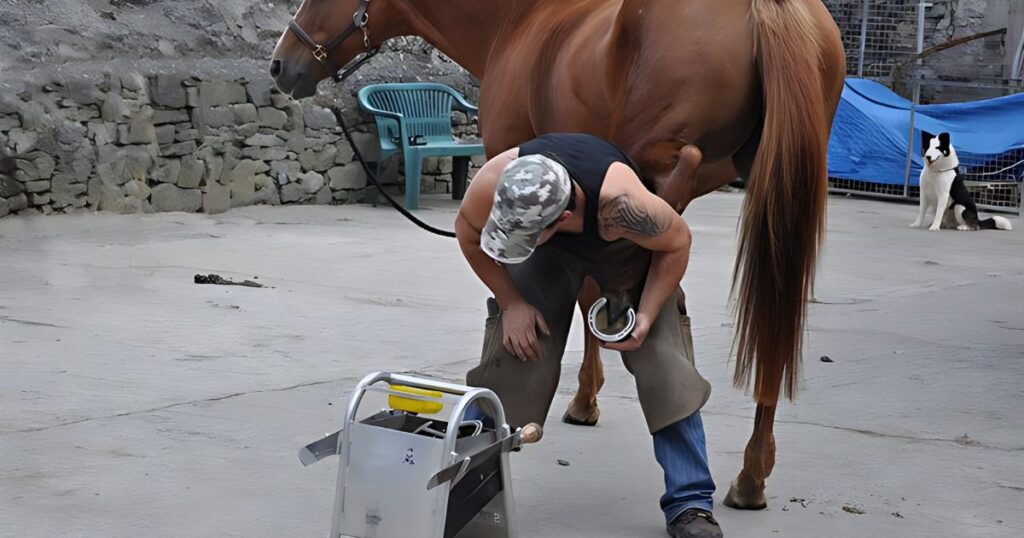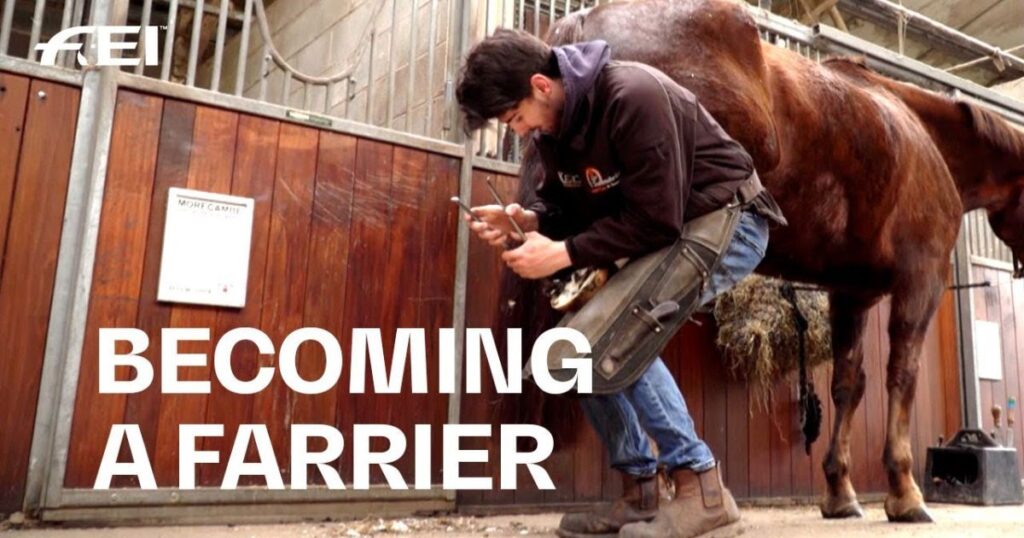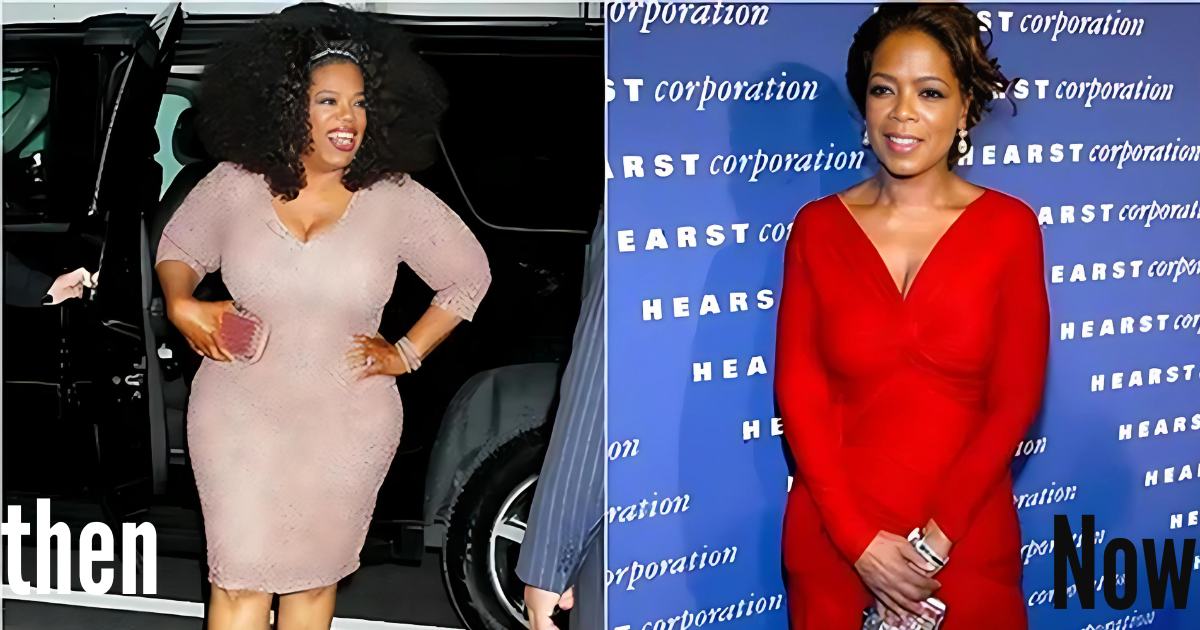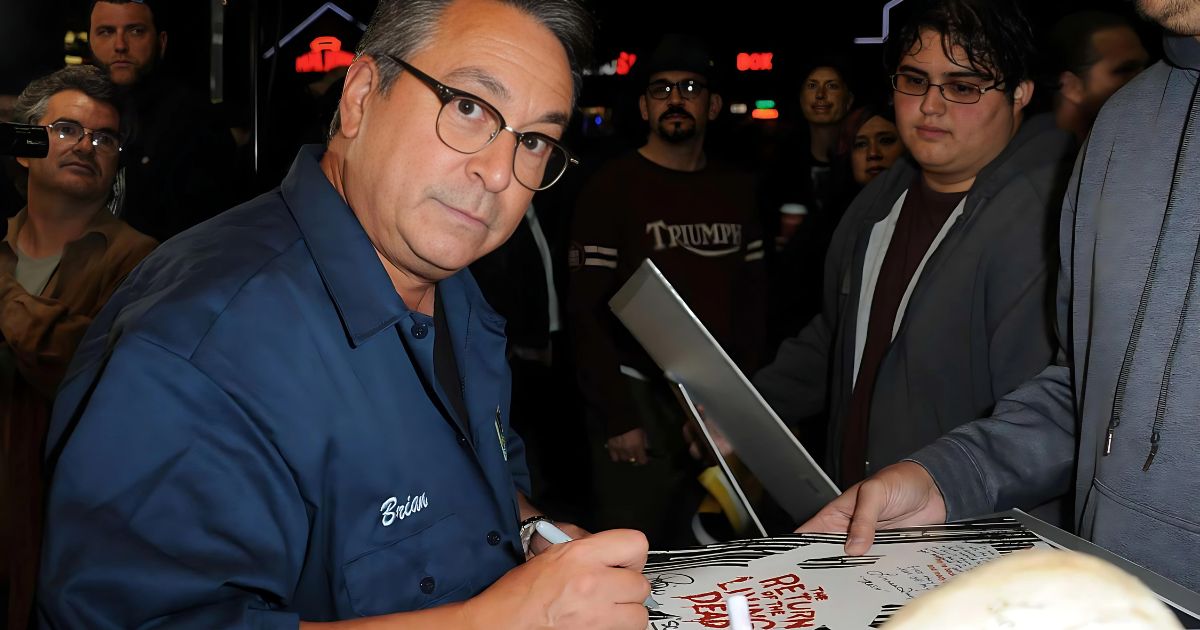What is a Farrier?
A farrier is a professional who assesses the health of equine hooves and applies corrective shoes or therapeutic devices like pads and braces. This helps manage medical conditions like laminitis, enhances performance, and prevents excess hoof wear and injury.
But, a good farrier is part horse osteopath and part blacksmith. Farriers must excel in the following areas:
- Anatomy – Understanding equine anatomy intimately, especially hoof and lower leg bone structure, ligaments, and soft tissues.
- Disease Identification – Recognizing symptoms of common hoof diseases like thrush, white line disease, and laminitis.
- Trimming – Properly trimming hooves to restore optimal balance and function.
- Hot Shoeing – Forging and expertly fitting handmade shoes to cushion, support, and protect hooves.
- Cold Shoeing – Precisely shaping, modifying, and nailing on pre-made shoes.
This diverse skill set allows farriers to enhance a horse’s comfort, performance, and quality of life. Whether preventing injury, correcting growth abnormalities, or treating illness, a reputable farrier is invaluable to any horse owner.
Read More: Digital News Planet
Origins of Horseshoeing
Humans have utilized horses for transportation, agriculture, warfare, and sport for thousands of years. As early equines transitioned from soft, forgiving pastures to hard roads and surfaces, their hooves required protection.

The earliest horseshoes have been traced to Asia, where the first nailed shoes appeared around 1000 BC to 400 BC. These early shoes were crude iron plates nailed to the hoof wall that shielded horses from wear and tear during long marches over rough terrain.
As cavalry gained prominence in wartimes, farriery became an essential military role, leading to innovations that balanced speed, traction, and injury prevention. Farriers were also highly valued in civilizations heavily reliant on horses for transport, like the Roman Empire.
Into the Middle Ages, the farrier emerged as a distinct European occupation. Early guilds, apprenticeship programs, and eventually formal training schools allowed the trade to develop and knowledge to accumulate.
Advancements in metallurgy, tools, and forging techniques drove improvements in horseshoe design through the 17th to 19th centuries. Speciality shoes helped horses meet the demands of pulling heavy loads or working long hours ploughing fields. Quality farriery was also critical for the emergence of professional cavalry units, thoroughbred racing, and recreational riding.
Today, modern farriers integrate state-of-the-art medical findings, materials science, and engineering alongside time-honoured techniques to evolve the craft further.
How to Become a Farrier
Aspiring farriers have a few educational paths to access this rewarding yet physically demanding trade:

Apprenticeship
Historically, serving under a skilled mentor was the only option to pick up territory techniques. This apprenticeship approach remains the most popular training method. Over 12-36 months, apprentices develop competencies like:
- Hoof trimming/balancing
- Hot shoeing and forging
- Custom shoe fabrication
- Recognizing hoof ailments
- Business operations
Apprentices gain well-rounded abilities by assisting a reputable farrier on appointments across varied environments and horse needs. Patience and persistence through this steep learning curve pay off tremendously.
Hallmarks of a Good Farrier
In many areas, farriers must be formally credentialed before legally practising. Farriers in the U.S. and Canada can earn professional certifications like CJF (Certified Journeyman Farrier) through rigorous testing on medical knowledge, forging competence, and practical shoeing skills.

Along with credentials, several traits set truly exceptional farriers apart:
- Patience – Willingness to explain treatment options and address all owner concerns. Take your time with visits, even with a packed schedule.
- Communication – Clearly articulates observations, shoeing objectives, and aftercare instructions. Answers questions thoroughly.
- Attention-to-Detail – Notices subtle hoof irregularities and variations in gait. Custom tailors every trim and shoe.
- Creativity – Masters traditional techniques but experiments with novel tools, materials, and approaches seeking better outcomes.
- Curiosity – Constantly deepening medical understanding and expanding skillset through continuing education.
- Compassion – Genuinely cares about each horse’s comfort and owner’s peace of mind.
With advanced expertise, artistry, and work ethic, excellent farriers have built strong reputations via word-of-mouth and delivered exceptional service for years. Their passion and dedication to doing what’s best for the horse shine through.
Tools of the Trade
Farriers employ an extensive toolkit to assess hooves and fashion shoes and attach them securely. While a skilled farrier can improvise with standard tools when needed, these are the essentials found in every professional’s truck and forge:

Hoof Knives – Various shaped knives with short, sturdy blades for cleaning feet, shaping hoof walls, and trimming sole/frog.
Nippers – Large clamping pincers akin to heavy-duty nail clippers for initial coarse trimming.
Rasp – Coarse file for smoothing trimmed edges.
Hammers – Mainly used to shape hot steel on an anvil. Some speciality hammers help fit/remove shoes.
Tongs – For securely holding hot metal shoes and manoeuvring them against hooves during forging.
Anvil and Forge: Farrier’s mobile workshop features a heating forge to enable metalworking.
Shoeing Forms: Solid metal forms in various sizes/shapes conform shoes against desired modifications.
Clinchers and Pull-Offs: After driving nails through the shoe and into the hoof wall, clinchers bend, and secure nail ends snugly against the shoe. Pull-offs extract any damaged or poorly positioned nails.
Hoof Testers: Devices that squeeze the hoof wall to reveal soreness and indicate underlying problems.
Hoof Knife and Stand: Freestanding knife sharpener maintains critical tool edges.
Other standard equipment includes hoof nippers for initial trimming, hoof packing for protecting freshly trimmed hooves, rasps for precision filing, clinch cutters for post-shoeing adjustments, shoeing boxes to organize tools onsite, leg braces to lift hooves safely, and speciality shoes like orthopaedic correction plates.
Top-quality German and American tools from trusted brands like Bloom Forge, Mustad, and Diamond dominate professional workshops – a worthwhile investment that lasts years. Though with skill and perseverance, many historical and modern-day farriers demonstrated mastery using self-fashioned instruments.
The Foot Fundamentals: Anatomy and Care
Before exploring the art of trimming and shoeing, it helps to understand critical structures and functions within the equine hoof capsule. Let’s break down what makes healthy hooves tick.
Exterior Hoof Capsule
The hoof wall is akin to our fingernails – comprised of the protein keratin for hardness and flexibility. Depending on breed and age, the wall grows down from the coronary band encircling the upper hoof to a thickness of around 1⁄4 to 1⁄2 inches; this keratin sheath protects internal structures and gives form to the hoof.
The periople is a protective layer coating the outer hoof wall. It helps prevent cracks from constantly expanding and contracting walls with changing moisture levels.
Delicate and often underestimated, the sole is a dense, supportive tissue beneath the hoof. It interacts with the ground, bearing weight alongside walls. Flexing soles assist in pumping nutrient-rich blood throughout hooves while cushioning steps.
Finally, the frog is a flexible, triangular structure filling the back 1⁄3 of the foot, projecting from the sole’s middle. Its slip-resistant surface grips terrain while absorbing concussion from each footfall to prevent strain farther up the legs.
Interlaced with circulatory systems, these exterior structures receive nourishment to sustain the growth and flexibility needed for structural soundness.
Internal Structures
Suspended inside rigid skeletal walls, the coffin bone or distal phalanx is the final tubular bone in the limb system. Extending down and forward, it mirrors the hoof wall’s shape and angle. One of the giant sesamoid bones efficiently transfers forces from the leg into the ground. A healthy bone angle of around 50-60° evenly distributes weight without excess strain.
Shock-absorbing cartilage called the digital cushion runs above and behind the coffin bone within the frog area.
Finally, attaching the coffin bone to the hoof capsule is the intricate laminae network. Dermal laminae tightly interlock with sensitive laminae lining the coffin bone surface, anchoring it like Velcro – allowing slight vertical movement while resisting horizontal rotation.
FAQs:
1: What is a farrier called today?
A farrier is still referred to as a farrier today. Other standard terms for a professional who trims and shoes horse hooves include horseshoer, hoof care specialist, and blacksmith.
2: Do farriers make money?
Yes, farriers can make a decent living. Experienced farriers earn $35,000 to $50,000 annually through mobile shoeing services and additional training fees. Top farriers specializing in show horses or advanced therapeutic work can make over $100,000 annually.
3: Is it Ferrier or Farrier?
The correct spelling is farrier. Historically, a Ferrier was a person who operated ferry boats transporting people and goods across bodies of water.
4: What does a farrier cost?
Farrier fees often range from $35 to $100 to trim and shoe one horse. Rates vary greatly depending on region, travel distance, specialized shoeing needs, additional leg/hoof medical services, and the farrier’s skill level and certifications.
5: Is a farrier a career?
Yes, professional farriery is a full-time career for talented horseshoers. Beyond regular hoof care and shoeing routes, career farriers teach apprentices and clinics, judge competitions, research innovations, and even transition to veterinary medicine, focusing on equine podiatry issues.
6: What is the job of a farrier?
A farrier’s core job responsibilities involve:
Assessing horse hooves.
Trimming overgrowth.
Rebalancing feet.
Fabricating and shaping horseshoes.
Expertly nailing on shoes to enhance performance and prevent injury.
Addressing any abnormalities or diseases as early as possible.
Farriers mix artistry, science, and skill to keep horses sound.
7: Do horses enjoy farrier?
Many horses do enjoy visits from the farrier. The hoof trimming and balancing process, in particular, can bring relief from discomfort due to overgrowth or imbalance. Therapeutic shoes adequately fitted by a trusted farrier also relieve chronic issues like laminitis. Through positive reinforcement training and ensuring an educated, patient farrier, horses can view it as a pleasant experience.
8: Does a farrier have teeth?
Farriers focus on hooves rather than teeth. Trained veterinarians or horse dentists perform equine dentistry, such as tooth floating and mouth adjustments. However, farriers may spot dental issues while working and notify the owner a specialist should inspect the mouth.
9: Are farriers in demand?
There is a strong demand for skilled farriers worldwide. Qualified farriers trained through quality apprenticeships or certification programs often have their pick of clients. The extensive riding, racing, ranching, and show-horse industries can only function with dedicated hoof care. Retiring farriers have big shoes to fill.
10: Can girls be farriers?
Absolutely. Farriers have historically been predominately male, given the profession’s physicality, connection to blacksmithing, and reliance on mentorship. However, female farriers have made great strides in establishing themselves as talented, hardworking horseshoers via formal training programs and breaking down outdated barriers.
11: Do farriers treat cows?
Bovine hoof care, like trimming overgrowth on cattle hooves, falls under the job duties of farm caretakers, dairy workers, or livestock specialists rather than professional farriers specialized in equines. However, the principles of balancing weight and preventing irregular wear do guide bovine hoof maintenance.
12: What is the age limit for farriers?
There is no set retirement age for farriers who avoid significant injury and remain fit for demanding work. Some work well into their 60s and 70s. Staying active with a balanced routine, limiting overworking horses, integrating apprentices for help, and shifting to more consulting/teaching roles preserves longevity.
13: What do farriers wear?
Farriers wear durable jeans or work pants paired with thick cowboy boots to protect their legs while working closely with horse legs/hooves. Heat-resistant gloves, leather aprons, and chaps guard against occupational hazards. Safety glasses, hearing protection devices, and face masks are typical when using noisy grinders on hooves or shoeing in dusty environments.
14: What industry is a farrier?
Farriers fall under the agricultural sector and light manufacturing industry as craftsmen manipulating steel into horseshoes. Farriers are also allied professionals supporting the thoroughbred racing sector and equine sporting industry by optimizing mount performance and preventing injury.
15: Is a farrier a blacksmith?
Farriers evolved from the blacksmithing trade of medieval times, specializing in metalwork and forging tools. Today’s professional farriers uphold blacksmithing traditions of heating and shaping metal horseshoes. However, modern farriers require deep knowledge of equine anatomy, physiology, and treatment regimens beyond the general metal shaping skills expected of a traditional blacksmith.





